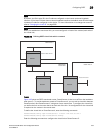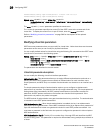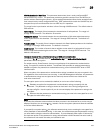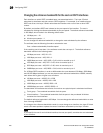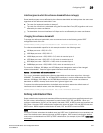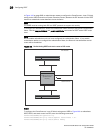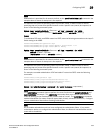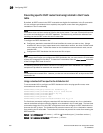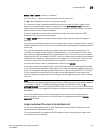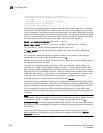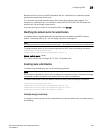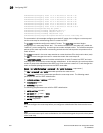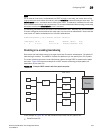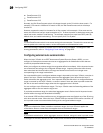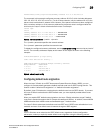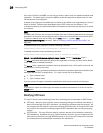
PowerConnect B-Series FCX Configuration Guide 951
53-1002266-01
Configuring OSPF
29
Syntax: deny | permit <source-ip> <wildcard>
The <ACL-name> | <ACL-id> parameter specifies the ACL name or ID.
The in command applies the ACL to incoming route updates.
The <interface number> parameter specifies the interface number on which to apply the ACL.
Enter only one valid interface number. If necessary, use the show interface brief command to
display a list of valid interfaces. If you do not specify an interface, the Dell PowerConnect device
applies the ACL to all incoming route updates.
If you do not specify an interface type and interface number, the device applies the OSPF
distribution list to all incoming route updates.
The deny | permit parameter indicates whether packets that match the policy are dropped or
forwarded.
The <source-ip> parameter specifies the source address for the policy. Because this ACL is input to
an OSPF distribution list, the <source-ip> parameter actually is specifying the destination network
of the route.
The <wildcard> parameter specifies the portion of the source address to match against. The
<wildcard> is in dotted-decimal notation (IP address format). It is a four-part value, where each
part is 8 bits (one byte) separated by dots, and each bit is a one or a zero. Each part is a number
ranging from 0 to 255, for example 0.0.0.255. Zeros in the mask mean the packet source address
must match the <source-ip>. Ones mean any value matches. For example, the <source-ip> and
<wildcard> values 4.0.0.0 0.255.255.255 mean that all 4.x.x.x networks match the ACL.
If you want the policy to match on all destination networks, enter any any.
If you prefer to specify the wildcard (mask value) in Classless Interdomain Routing (CIDR) format,
you can enter a forward slash after the IP address, then enter the number of significant bits in the
mask. For example, you can enter the CIDR equivalent of “4.0.0.0 0.255.255.255” as “4.0.0.0/8”.
The CLI automatically converts the CIDR number into the appropriate ACL mask (where zeros
instead of ones are the significant bits) and changes the non-significant portion of the IP address
into zeros.
NOTE
If you enable the software to display IP subnet masks in CIDR format, the mask is saved in the file in
“/<mask-bits>” format. To enable the software to display the CIDR masks, enter the ip
show-subnet-length command at the global CONFIG level of the CLI. You can use the CIDR format
to configure the ACL entry regardless of whether the software is configured to display the masks in
CIDR format.
If you use the CIDR format, the ACL entries appear in this format in the running-config and
startup-config files, but are shown with subnet mask in the display produced by the show ip
access-list command.
Using an extended ACL as input to the distribution list
You can use an extended ACL with an OSPF distribution list to filter OSPF routes based on the
network mask of the destination network.
To use an extended ACL to configure an OSPF distribution list for denying specific routes, enter
commands such as the following.



